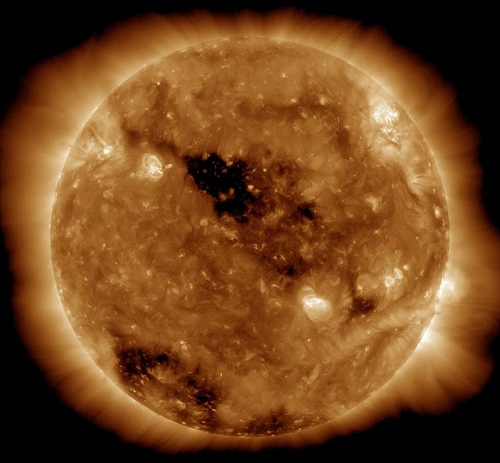
NASA has recently discovered a massive hole on the sun's surface that's big enough to fit 50 Earths inside.
According to experts, this hole can allow supercharged particles to escape from the sun and cause geomagnetic storms on Earth.
Technically, the hole found on October 10 on the sun's surface, also known as the corona, is not exactly a hole. It is actually a cold region in the plasma aura that appears black when viewed through X-Ray and ultraviolet images, CNET reported.
NASA noted that coronal holes such as this one are not an uncommon phenomenon. Since this region is low in gas and energy compared to the rest of the sun's surface, it causes the magnetic field in this area to drop.
This results in the discharge of solar winds that travel can up to 800 kilometers per second. When these reach Earth and interact with the planet's own magnetic field, they turn into geomagnetic storms.
"A geomagnetic storm is a major disturbance of Earth's magnetosphere that occurs when there is a very efficient exchange of energy from the solar winds into the space environment surrounding Earth," the National Oceanic Atmospheric Administration (NOAA) stated in its website.
"These storms result in variations in the solar wind that produces major changes in the currents, plasmas and fields in Earth's magnetosphere," the agency continued. "The solar wind conditions that are effective for creating geomagnetic storms are sustained periods of high-speed solar wind, and most importantly, a southward directed solar wind magnetic field at the dayside of the magnetosphere."
These unique storms can affect Earth in a variety of ways such as disrupting radios, radar and GPS. The solar winds can also cut-off satellite feeds, according to World Tech Today.
Aside from technological devices, geomagnetic storms can also the navigational abilities of certain animals that rely on Earth's magnetic fields to find their way such as pigeons. Whales can also get confused because of this phenomenon and may end up getting stranded in beaches.
Geomagnetic storms also have another effect that is spectacular to watch. Aurora borealis, which is basically a magnificent natural light show in the sky, is also caused by the interaction between the solar winds and Earth's magnetic field.
According to a forecast by NOAA, aurora borealis can be seen across Canada, Greenland, northern Scandinavia and northern Russia within the next few days.
To check out more images of the sun's coronal hole, readers can head over to NASA's Solar Dynamics Observatory website.














